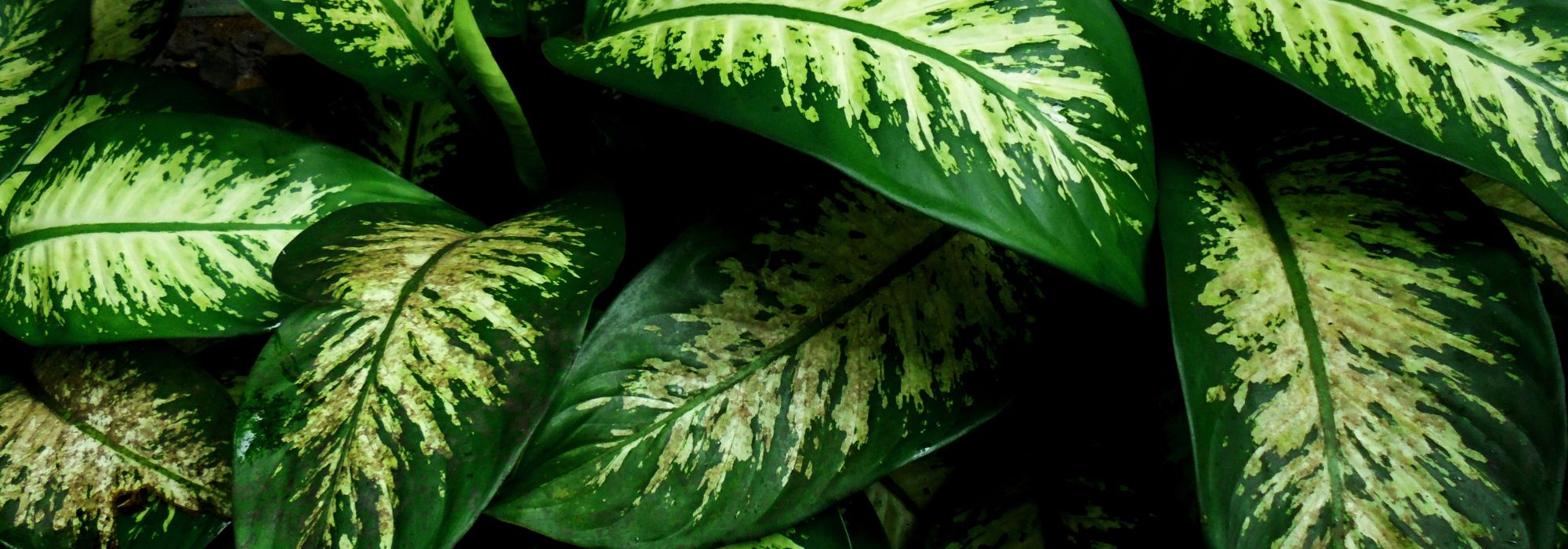
Dieffenbachia: growing and care
Contents
Dieffenbachia in a nutshell
- The Dieffenbachia, or dumb cane, is a tropical plant from the family of Araceae.
- It is distinguished by its large, variegated foliage, which is very decorative.
- It enjoys filtered light, warmth, and good ambient humidity.
- Its care involves moderate watering and regular fertilisation in spring and summer.
- Its toxic sap requires handling with care and keeping it out of reach of children and pets.
The word from our expert
The Dieffenbachia, also known as dumb cane, belongs to the large family of Araceae. Native to the tropical forests of Central and South America, it was named in honour of Joseph Dieffenbach, a 19th-century gardener. This houseplant, cherished for generations, captivates with its spectacular foliage and its ability to adapt to bright interiors, but without direct sunlight.
Its elegant habit, supported by a fleshy stem marked with foliar scars, highlights wide, glossy leaves, often variegated with white, cream, or yellow. Varieties such as Dieffenbachia ‘Camilla’ with its light centre or ‘Tropic Snow’ with its marked contrast, offer a refined plant decor that suits both modern rooms and more classic settings. The variety ‘Crocodile’, with its veins reminiscent of reptile skin, particularly draws the eye.
Easy to grow, the Dieffenbachia thrives in a rich, well-draining substrate, kept slightly moist. A temperature between 18 and 25 °C and a humid atmosphere replicate its natural conditions and ensure vigorous growth. Regular but moderate watering, combined with feed for green plants in spring and summer, guarantees dense, colourful foliage throughout the year.
To maintain its harmonious appearance, simply remove yellowing leaves and, if necessary, trim the stem to encourage the emergence of new shoots. As the dumb cane produces toxic sap, it is essential to handle it with gloves and keep it out of reach of children and pets. Regularly dusted, its foliage regains its brilliance and continues to play its major decorative role in our interiors.
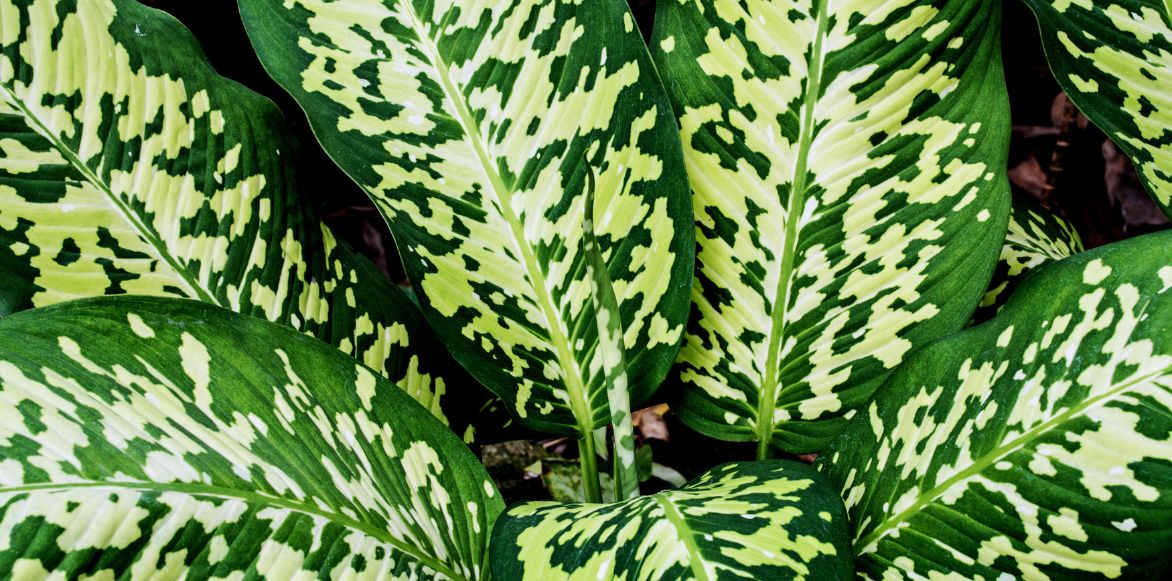
The Dieffenbachia or dumb cane is a timeless classic among houseplants.
Botany and description
Botanical data
- Latin name Dieffenbachia sp.
- Family Araceae
- Common name Dumb cane
- Flowering spring-summer (rare in cultivation)
- Height up to 2 m
- Sun exposure bright light without direct sunlight
- Soil type light and well-drained potting soil
- Hardiness frost-sensitive
Dieffenbachia, a member of the Araceae family, is named after the head gardener of the imperial palace in Vienna in the 19th century, Joseph Dieffenbach, to whom this genus was dedicated. It is also known by its common name dumb cane, a name linked to the toxicity of its sap, which can cause numbness of the tongue and mucous membranes.
In its natural habitat, Dieffenbachia grows in the tropical forests of Central and South America, sheltered from direct sunlight, where it thrives in a warm and humid atmosphere. These conditions explain why this plant has become one of the most popular houseplants: it adapts well to homes, tolerates partial shade, and offers spectacular foliage that brightens rooms without requiring complicated care.
Among the many species and hybrids cultivated, certain varieties stand out particularly in modern interiors. The Dieffenbachia ‘Crocodile’ attracts attention with its dark green foliage veined in white, reminiscent of reptile skin. The ‘Camilla’, valued for its compact habit, charms with its large leaves broadly marbled with cream at the centre. The Dieffenbachia ‘Tropic Snow’ delights with its broad dark green leaves elegantly variegated with white, providing a bright contrast. These cultivars, selected for their beauty and robustness, explain the ongoing success of Dieffenbachia in our homes.
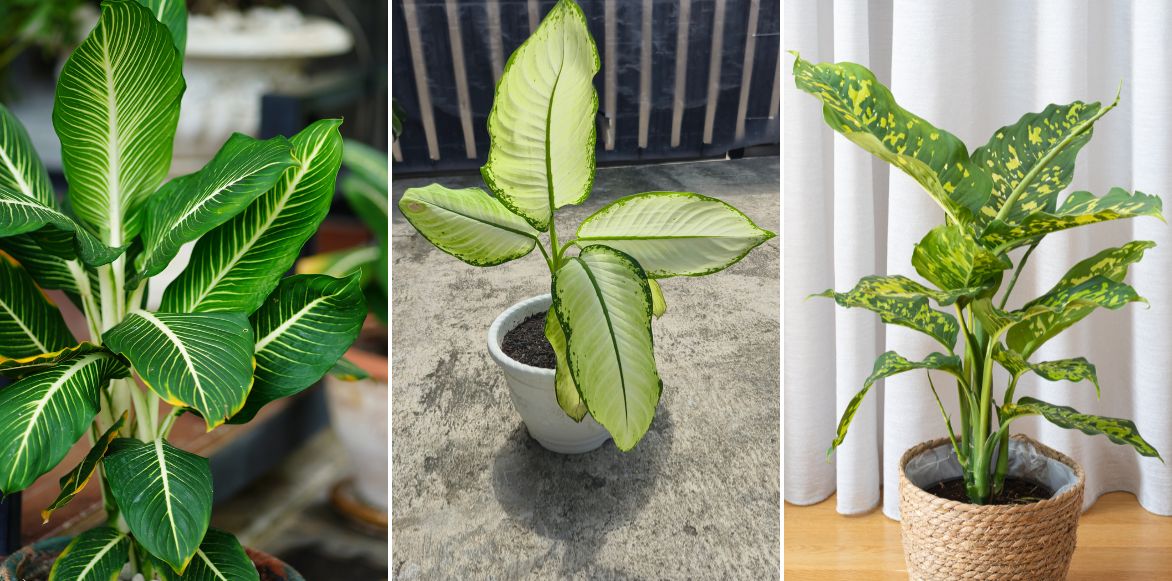 Among the many varieties of Dieffenbachia, all more beautiful than the last, the choice is difficult. Adopt them all!
Among the many varieties of Dieffenbachia, all more beautiful than the last, the choice is difficult. Adopt them all!
Description of the botanical genus Dieffenbachia
Dieffenbachia appears as a perennial herbaceous plant with an upright silhouette, resembling that of a small tropical bush. Its root system, fibrous and vigorous, spreads superficially but densely, allowing it to anchor its fleshy stem firmly in the humus-bearing and light soils of the forests where it naturally grows. The trunk, actually a thick and succulent stem, stands upright and bears the scars of former leaves, sometimes giving the base a ringed appearance, as seen in Dieffenbachia seguine, one of the most common species.
The plant does not truly emit lateral branches: it rather develops a succession of leaves arranged in a spiral along the stem, which accentuates its slender appearance. These leaves, broad and ovate to oblong, are borne on long sheathing petioles that partially envelop the stem. Their lamina, often leathery and glossy, features variegations of white, cream, or yellow that vary according to species and cultivars, such as the spectacular Dieffenbachia maculata ‘Camilla’ with light centres, or D. amoena ‘Tropic Snow’ whose whitish veins stand out against a dark green background.
Flowering, although rare indoors, consists of a spadix surrounded by a spathe, typical of the Araceae family. The spadix, cylindrical and discreet, is often greenish or cream and is more decorative than truly ornamental. In its natural habitat, pollination can lead to the production of small fleshy berries, usually orange when ripe, but this phenomenon remains exceptional at our latitudes where Dieffenbachia is cultivated as a houseplant.
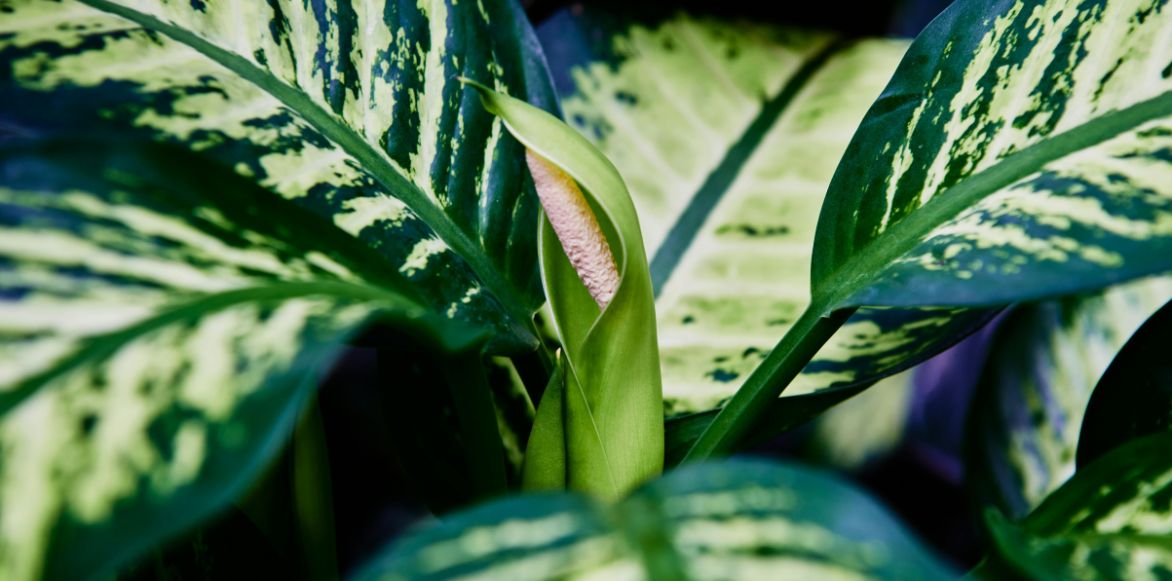 Very rare in cultivation, the inflorescence of Dieffenbachia is typical of the Araceae family.
Very rare in cultivation, the inflorescence of Dieffenbachia is typical of the Araceae family.
Dieffenbachia is an amazing plant!
The sap of Dieffenbachia, abundant and milky, contains calcium oxalate crystals in the form of raphides, responsible for intense irritation of the mucous membranes upon contact or ingestion. This toxicity requires handling the plant with care, especially during repotting or pruning, avoiding any contact with the eyes or mouth.
Adapted to the partial shade of tropical forests, Dieffenbachia has particularly effective foliage for capturing diffuse light. Its large leaves with broad and glossy lamina maximise the photosynthesis surface in reduced light conditions. This ability allows it to thrive where many other plants wither, making it a preferred plant for urban interiors.
Its rapid growth is another remarkable characteristic. In good conditions of warmth and humidity, it can continuously produce new leaves, regularly renewing its foliage and giving it a consistently fresh and green appearance. Some species, such as Dieffenbachia amoena, develop thick stems that can reach over a metre in height, while compact cultivars like ‘Camilla’ maintain a smaller size, suitable for small spaces.
Finally, the plant has a strong capacity for physiological adaptation, tolerating brief periods of drought thanks to its fleshy tissues, while fully enjoying a fresh and rich substrate. This plasticity explains its longevity in pots and the ease with which it integrates into a variety of indoor environments.
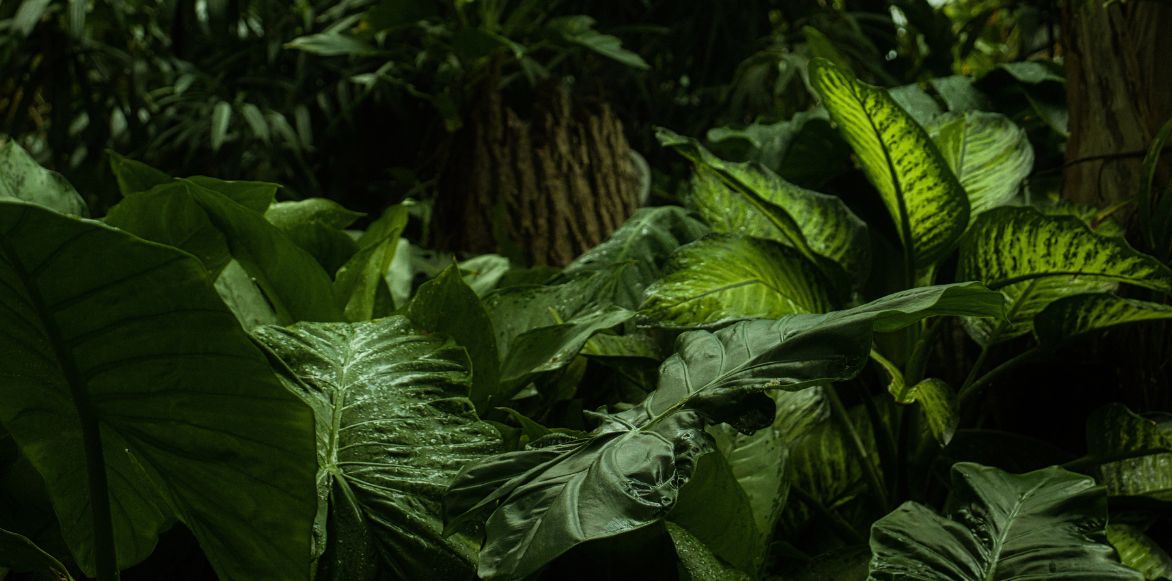 Growing naturally under the canopy, Dieffenbachia has had to show ingenuity to survive.
Growing naturally under the canopy, Dieffenbachia has had to show ingenuity to survive.
Our selection of Dieffenbachia
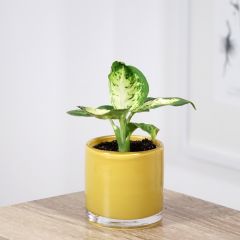
Dieffenbachia maculata Amy - Dumb cane
- Höhe bei Reife 90 cm
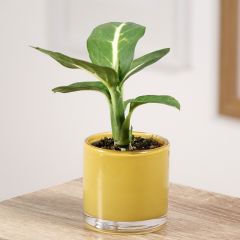
Dieffenbachia Sterling - Dumb cane
- Höhe bei Reife 80 cm
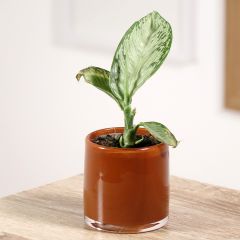
Dieffenbachia seguine Tropic Snow - Dumb canes
- Höhe bei Reife 90 cm
Planting a Dieffenbachia
When to plant?
Dieffenbachia is best planted in spring, when the vegetative growth begins and natural light increases. At this time, the plant copes better with handling and quickly adapts to its new container.
What pot and substrate to use for a Dieffenbachia?
The substrate should be rich and light, retaining moisture while remaining draining. An ideal mixture formed of potting soil for green plants, peat or coconut fibre for aeration, and perlite or coarse sand for drainage is recommended. The bottom of the pot should always be lined with a layer of clay balls or gravel to prevent water stagnation.
Choosing the right container is essential: a pot with a diameter slightly larger than the root ball, deep enough to accommodate its fibrous root system, is recommended. Plastic retains moisture better, while terracotta promotes better aeration but requires more frequent watering.
Planting and repotting
During planting, gently place the root ball in the centre of the pot, fill in with the prepared mixture, pressing down lightly to avoid air pockets, then water thoroughly to moisten the substrate and encourage rooting.
Repotting is done every two to three years, usually in spring, when the roots start to intertwine or emerge through the drainage holes. This is a good time to remove damaged roots, refresh part of the substrate, and choose a slightly larger pot, without excess, as an oversized container would slow growth. Between repottings, it is possible to simply top-dress, meaning replacing the top layer of substrate with fresh, nutrient-rich potting soil to stimulate the plant without disturbing its root system.
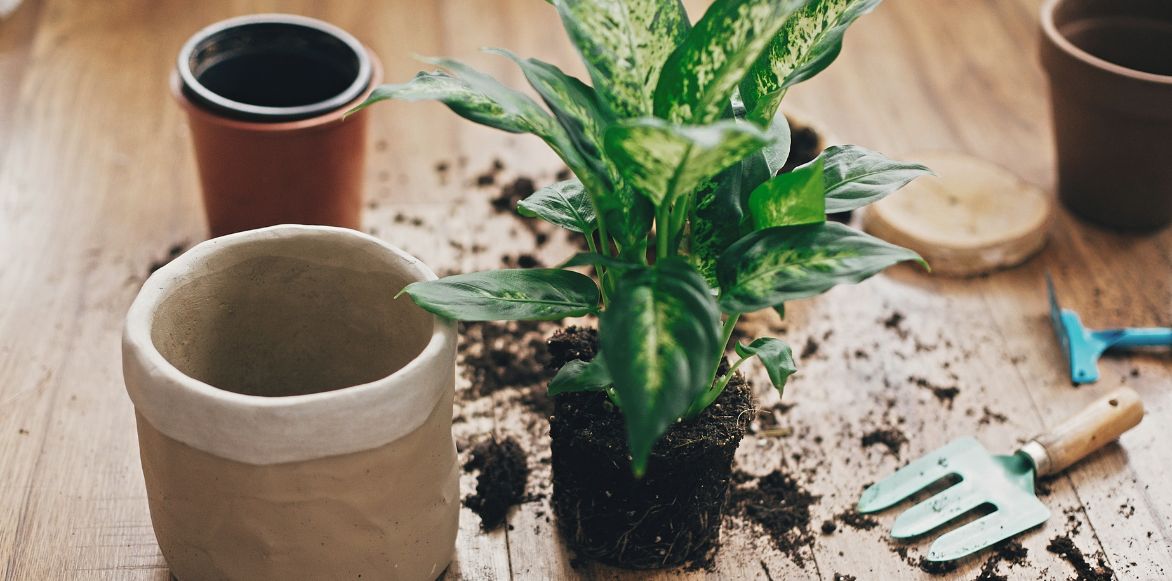
Planting a Dieffenbachia is done in quality potting soil.
Where to place a Dieffenbachia?
In terms of placement, Dieffenbachia thrives in bright, but filtered light, away from direct sunlight that would scorch its foliage. It grows well at temperatures between 18 and 25 °C, with a high ambient humidity. In dry interiors, especially in winter with heating, it appreciates regular misting of the foliage or the presence of a water tray with pebbles under its pot.
Care for Dieffenbachia
Watering
Dieffenbachia enjoys regular but moderate watering, with its substrate needing to remain slightly moist without ever becoming waterlogged. During the growth period, from spring to the end of summer, it is advisable to water as soon as the surface of the potting soil begins to dry. In autumn and winter, watering should be spaced out to avoid excess moisture that could lead to root rot. The water used should ideally be at room temperature and low in lime, which helps maintain the beauty of its leaves.
Fertilisation
Fertilisation supports its vigorous growth: a liquid fertiliser specially formulated for green plants, applied every two to three weeks in spring and summer, enhances the colour and density of its foliage. During the cold season, fertilisation should be suspended or significantly reduced, as the plant enters a phase of relative dormancy.
Pruning and Cleaning
Pruning is limited for Dieffenbachia. Generally, one simply removes damaged or yellowing leaves, cutting cleanly at the base of the petiole, which stimulates the emergence of new shoots. For older specimens that have lost their lower leaves, it is possible to cut back the main stem above a node to encourage the formation of lower shoots, giving the plant a denser habit.
To maintain its glossy leaves and promote gas exchange, it is useful to regularly dust the leaves with a damp cloth, without using polishing products that could block their stomata.
Reminder! Caution, as the sap of Dieffenbachia is toxic, it is advisable to wear gloves when pruning, repotting, or cleaning leaves, and to wash hands thoroughly afterwards. Ensure the plant is kept out of reach of children and pets.
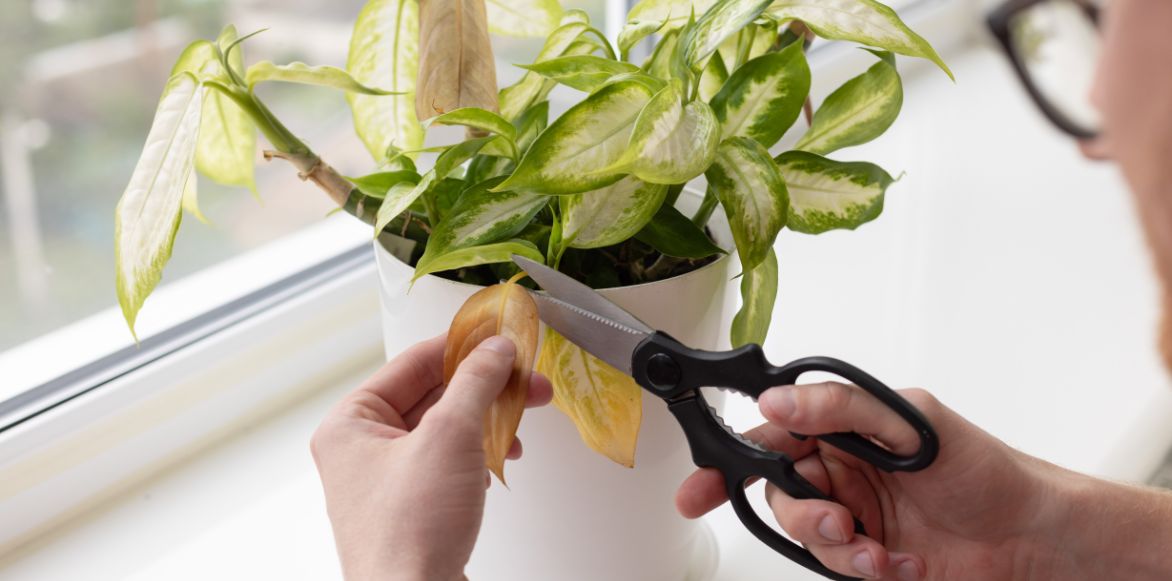
Yellow and wilted leaves should be removed regularly.
Pests and diseases in Dieffenbachia
Dieffenbachia is a robust plant, but it can be susceptible to a few pests and sensitive to certain diseases when growing conditions are not ideal.
Pests
The mealybugs, which reside in the axils of the leaves and on the stems, appear as white cottony masses and weaken the plant by sucking its sap.
The red spider mites, common in dry conditions, cause yellowing punctuated by fine spots and dull foliage, sometimes covered with discreet webs.
The aphids, although rarer indoors, can also settle on tender young shoots and slow their growth.
In the event of an infestation, a thorough cleaning of the leaves with a damp cloth or a mild soapy solution is often sufficient to halt the infestation.
Diseases
Regarding diseases, excess moisture and poor ventilation promote the onset of root rot caused by soil fungi, which can be fatal if not addressed in time. This results in a softening of the base of the stem, as well as brown, mushy roots. In overly humid and cool conditions, foliar spots of fungal origin may develop, marking the leaves with brown areas bordered by yellow.
Repotting in healthy substrate is necessary if root rot is suspected.
How to propagate your Dieffenbachia?
Stem Propagation
The propagation of Dieffenbachia is primarily achieved through stem cuttings, a simple method that faithfully preserves the characteristics of the cultivated varieties. In spring or summer, a vigorous section of stem with several nodes is taken. After removing the leaves from the lower part, this section is planted in a light, moist substrate, formed of turf and perlite or vermiculite, to encourage rapid rooting. A bright location without direct sunlight, combined with a stable temperature around 22 °C, stimulates the emergence of new roots. To maintain good humidity, it is recommended to cover the pot with a transparent plastic bag or place the cutting in a mini greenhouse, while regularly airing it to prevent mould.
It is also quite possible to take a stem cutting in water. Just remember to change the water every 3-4 days. It is advisable to repot the cutting as soon as the first roots appear.
Propagation by Stem Sections
Another technique involves using cane sections, that is, pieces of stem without leaves, which are placed horizontally on the surface of the substrate or vertically by pushing them a few centimetres into the soil. Each node is then capable of producing new shoots or roots, allowing several young plants to be obtained from a single mother plant.
Separation of Offsets
In some specimens, basal offsets may also appear at the base of the plant; they can be carefully removed with their roots and replanted individually.
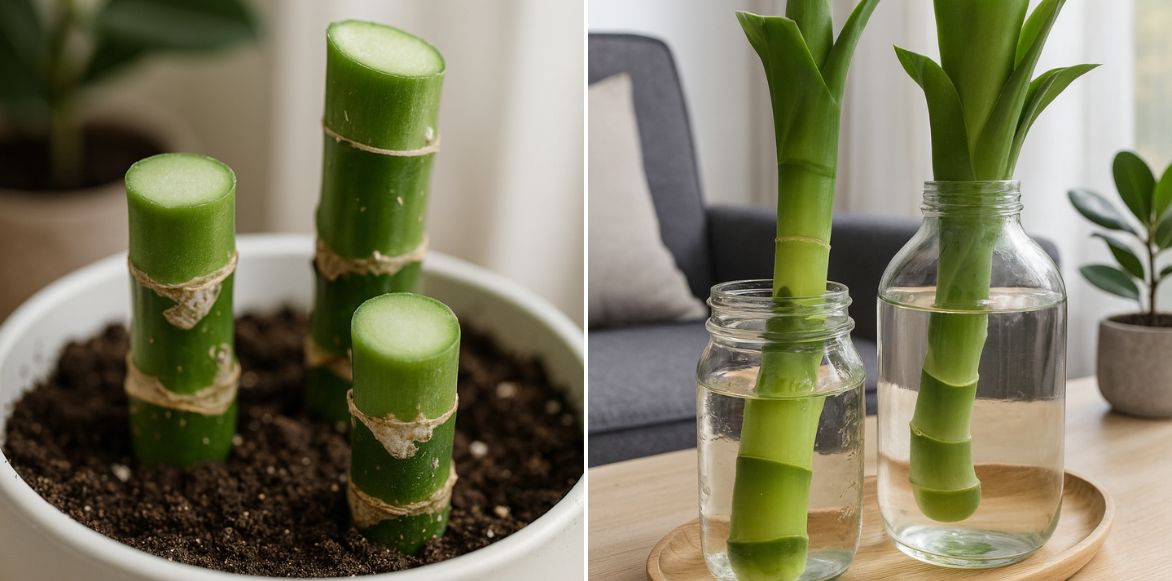
Dieffenbachia propagates well: by stem section (left) or by stem cutting in water (right) (Image enhanced by AI)
How to best integrate a Dieffenbachia into your home?
Dieffenbachia finds its perfect place in bright, contemporary interiors, where its variegated foliage adds a touch of exoticism and freshness. Its elegant silhouette and the richness of its patterns make it an ideal plant to adorn a living room, conservatory, or office benefiting from good light without direct sunlight. In an urban and modern style, its large graphic leaves complement clean lines and understated materials like metal or concrete. In a more classic or bohemian decor, it pairs well with light wood furniture or natural fibres, enhancing the impression of nature and warmth.
The choice of container plays a crucial role in showcasing it. A glazed ceramic pot or a varnished terracotta pot highlights its decorative foliage, while neutral-coloured cache-pots like white, beige, or grey accentuate its bright variegations. To emphasise its tropical appearance, it can be placed in tall planters that enhance the verticality of its stem. Compact varieties like ‘Camilla’ are well-suited to low, wide pots, creating a dense and elegant clump.
Open mini-terrariums can accommodate very young specimens or cuttings, but the plant will soon feel cramped.
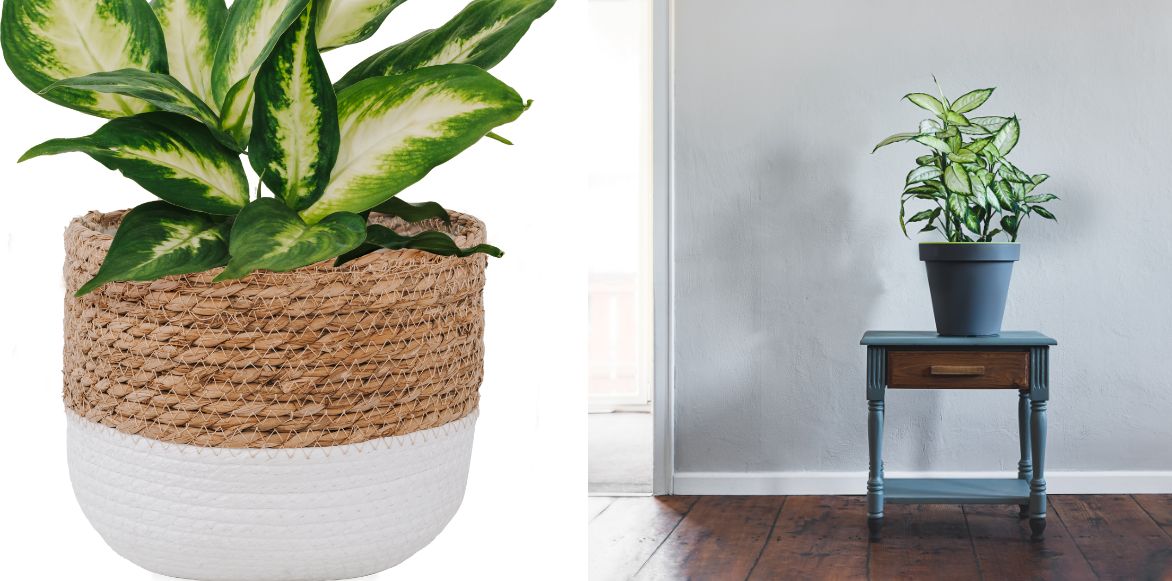
Dieffenbachia is self-sufficient, but the choice of pot to showcase it is important.
Useful resources
- Discover our range of indoor green plants and flowering plants to bring exoticism and elegance to your home.
- Our selection of books on indoor plants.
- Subscribe!
- Contents
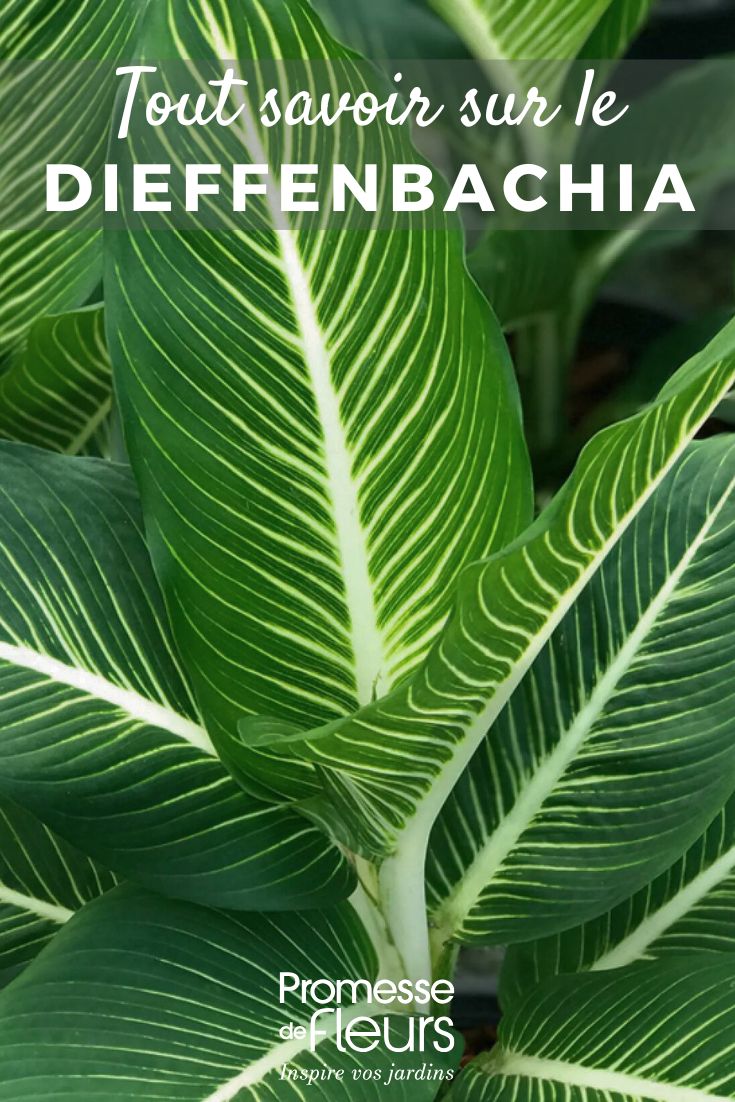































Comments